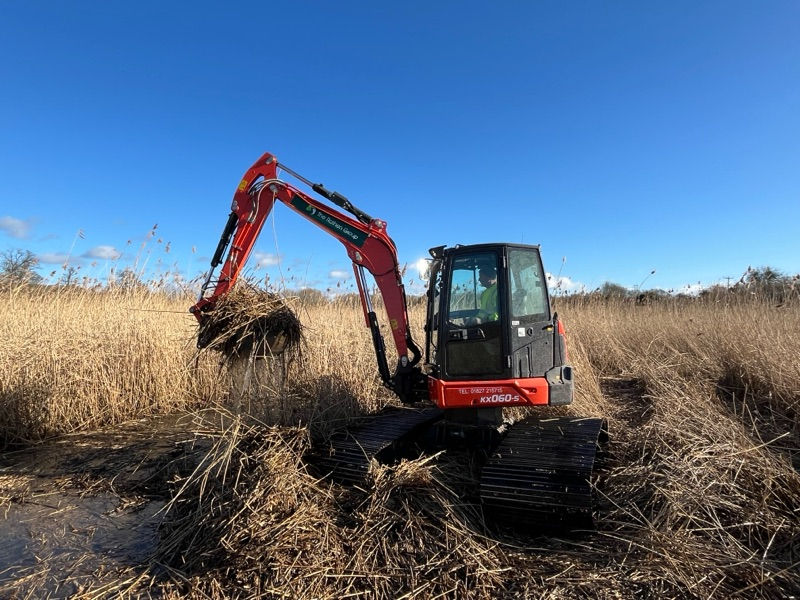
Canal Soft Bank Protection
Soft banks, solid strategy.
We protect and reinforce canal edges using sustainable, low-impact methods that work with the environment — not against it.
Bank Protection Services
Our Specialist Canal Soft Bank Protection Services
Canal soft banks are vulnerable to erosion, slippage, and water loss. Unlike hard concrete, rock, or steel barriers, these soft edges can become damaged by fluctuating water levels, poor compaction, or damage from roots and wildlife. The Rothen Group is skilled in soft bank protection and maintenance, preserving canal edges through low-impact solutions.
We use tried-and-tested techniques such as coir matting, reed planting, and hazel wattles, often paired with gabions or geotextiles, to stabilise banks and reduce erosion. Alongside bioengineering solutions, like planting trees or other vegetation, we can install reliable structural support that doesn’t disturb the natural harmony of a site.
Every site is different. We assess the cause and condition of the bank, determining the most effective solution. Whether it’s a failed lining, a cracked utility crossing, or a section of canal at risk of collapse, we develop a clear, practical plan backed by decades of experience.
Need to protect a vulnerable canal bank? Contact The Rothen Group for expert support and a free site assessment.


Gallery

FEATURED CASE STUDY
Habitat Creation Coney Meadows, Droitwich
Coney Meadows is part of a nationwide project to restore the UK’s wetlands. Since the 17th century, large areas of reedbeds have been stripped and converted into agricultural land, massively reducing the number of habitats available for wetland animals.

FEATURED CASE STUDY
Changing the Shape of the River Derwent, Derby
Following the storm seasons of 2023 & 2024, the EA set out to review its impact on the UK’s waterways. The River Derwent in Derby was flagged after a sonar scan of its navigation identified a scour hole – a direct result of heavy rainfall pushing sediment downstream.
When canals were first built 200 years ago, it was unfeasible to line every canal with a hard stone bank. Even in the centuries since, only a few sections of the UK’s 2,000-mile network have a hard bank – either stone or concrete.
A canal soft bank is a non-reinforced edge, often made of clay or soil and stabilised with vegetation. Soft banks make up the vast majority of canal edges in the UK. These banks use low-impact materials for erosion control and stability but require more upkeep.
What is a canal soft bank?
Canal soft banks are more prone to erosion, seepage, and collapse due to water flow, poor compaction, burrowing animals, and tree roots. If a collapse occurs, then an entire section of the waterway can be closed, which has a ripple effect through the network.
Unlike hard banks, soft banks require continual management, protection, and maintenance – otherwise, they can fail, leading to water loss, structural damage, and navigation issues.
Why do canal soft banks need protection?
Soft banks require softer protection solutions. While in some locations, it might be necessary to install pilings, we usually prefer to opt for natural, low-impact options.
That includes:
Coir matting
Reed planting
Hazel wattles
Gabion baskets or mattresses
Geotextiles
These solutions are low-cost, low-impact, and cause no issues with the local environment. In fact, hazel wattles, reeds, and geotextiles can even enhance biodiversity, acting as habitats for all kinds of species. Plus, by allowing vegetation to grow, they help reinforce the banks and reduce erosion over time.
What are the best methods for soft bank protection?
Yes. One of the biggest issues with soft banks is the risk of erosion. In curved sections, the outer edges are continually eroded, gradually altering the course of the canal. To tackle faster flows or unstable soils, we often combine soft engineering techniques with structural reinforcements like gabions or stone revetments for extra stability – especially if the bank is steep or high.
Gabions, reed beds, and other soft features also slow the water, absorbing the energy that causes erosion. Even something as simple as a gabion mattress can add distance between the canal edge and the bank.
Do soft bank solutions work in high-flow areas?
With the right materials and ongoing maintenance, soft bank protection can last decades. Proper installation and regular inspection are key to long-term performance.
How long do soft bank repairs last?
FAQ
Your Questions Answered
contract services
Related services
about us
A decade of
The Rothen Group
The Rothen Group is a trusted specialist in canal bank protection and waterway maintenance across the UK. With decades of experience, we deliver soft bank solutions that balance structural stability with environmental sensitivity.
We’ve worked on some of the country’s most well-used and historically significant canals, using practical, proven methods to control erosion and reinforce failing banks. From natural materials to hybrid solutions, we provide expert guidance, safe installation, and lasting results — all tailored to the demands of your site.















